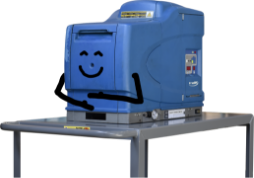Glue & Order: The Case of Glue vs. Machine

In the adhesive solutions world, the people rely on two separate, yet equally important things: The glue that allows them to successfully complete their applications, and the CGM team, who provide the expert knowledge and inventory needed to keep their supply full and their machines humming. These are their stories. (DUN-DUN!)
It was a typical day at the Chicago Glue and Machine office when a team member received a message from a customer about a possible glue-failure. “We’re having issues with the glue we received recently. The sealed cartons are opening back up after being packed in the freezer for storage. Has there been a change to the makeup or material?” Immediately, the team was on the case.
THE GLUE IN QUESTION
A picture provided by the customer showed the adhesive infraction in-progress, with one section of the adhesive bead “failing” to provide a fiber tear but the same bead of glue providing 100% fiber tear in a different section. After reviewing the evidence, the CGM team came to a solid conclusion: the glue was innocent. The formula for this glue had not changed and the adhesive cannot work in one section of the glue bead and not the other. Instead, it was the machine who was the culprit with compression or timing as it’s possible motive.
It looked as if the compression process took place after the glue had already cooled down and was not active, or the compression was not held properly in that section of the box. It’s something the team has seen a time or two before and it happens when an adequate amount of back pressure isn’t applied across the entire package or if the method of compression is a clamp or bar that is not square. Without back pressure, the initial flap can recede back into the cavity of the box and the secondary flap cannot be held to the glue while it is setting up. In the clamp or bar scenario, it isn’t square. The secondary flap can be held securely to the back portion of the box that is getting a fiber tear, but there is a void between the bar and the secondary flap in the front which causes a failure. This void allows the secondary flap to move away from the glue bead and again not stay under compression while the glue is setting up.
It was an open and shut case. (Dun-dun.)
SOLVING PROBLEMS, PROVIDING SOLUTIONS
Glue failures happen because no single thing – not even our beloved adhesives- are perfect. But that goes for machines too. We never want glue to take the rap for a machine that’s misbehaving! That’s why it’s crucial to work with a knowledgeable team who can look at the facts and find the right solution.
If you find yourself a witness to an adhesive failure, call the expert team at Chicago Glue and Machine at 1-(800)-GLUE or visit our website.












